What is Kaisen Donburi/Kaisendon?
Kaisendon (海鮮丼) is a bowl of fresh sashimi and other seafood on a bed of white rice. The fish used vary depending on the region, season, or personal preference. It is said to have been created after WWII and spread from northern Japan, including Hokkaido and the Tohoku region, to the rest of the country. Sashimi, such as tuna, salmon roe, and salmon, are particularly popular.
The term “Kaisendon” is sometimes used as a generic term for seafood bowls, including Tekkadon (tuna bowl), unidon (sea urchin bowl), kanidon (crab bowl), and Zukedon (marinated seafood bowl), which use single ingredients.
You can find the best Kaisendon in Hokkaido or places with fishing harbors where restaurants can get the freshest seafood.
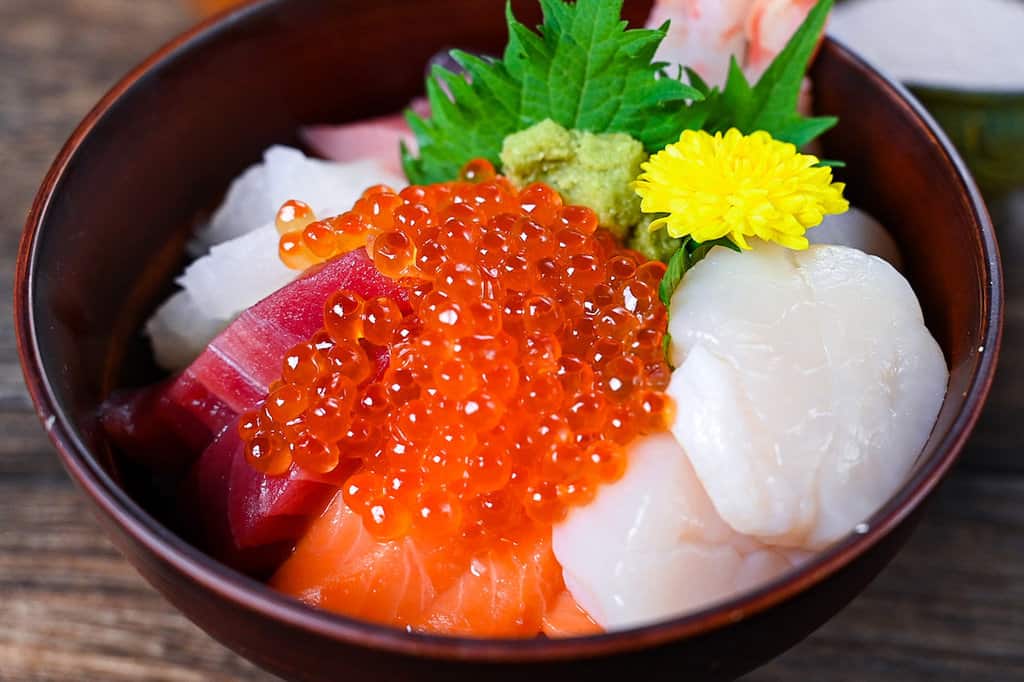
Common Seafood
If you think kaisendon as a general term means “bowl of fresh seafood”, you can guess there is no set ingredients to be used for this dish. However, it’s also true that there are preferred ingredients people like in Japan. This is the list of popular seafood ingredients (neta) for kaisendon:
- Tuna
- Sea urchin
- Scallops
- Ikura (salmon roe)
- Yellowtail
- Salmon
- Red snapper
- Sweet shrimps
- Squid
- Shirasu (whitebait)…etc
You can even choose what kind of seafood you want to include at particular restaurants. So mixing and matching different ingredients is free, depending on your preference. I will list some kaisendon ideas later in this post.
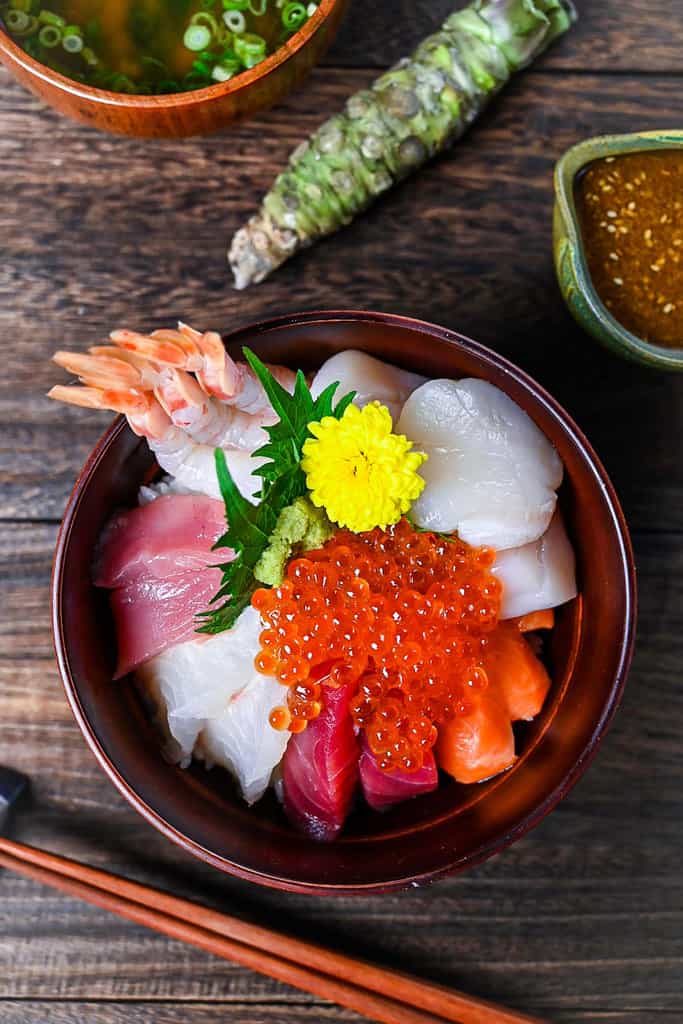
Sauce to Use for Kaisendon
To be honest, there is no real definite answer to that because it’s down to your preference. However, common sauces to be used are:
- Soy sauce
- Tsuyu sauce
- Kaisendon sauce
If you don’t want to make a special sauce, you can use soy sauce as kaisendon sauce. There’s nothing wrong with it. You know sushi will work if you think it is eaten with soy sauce.
The second option is tsuyu sauce for a sweeter flavor. When I can’t be bothered to make kaisendon sauce from scratch, I usually go for tsuyu sauce personally. The ultimate option is kaisendon sauce. There are different kinds of kaisendon sauce, but most generic ones are somewhat similar to tsuyu sauce with a slight kick. That being said, kaisendon sauce is sweet and savory type.
Because I cannot really make a recipe for kaisendon itself (because it’s just seafood putting on rice…), I will explain my recipe of special kaisendon sauce.
The details are in the recipe card, but I use:
- Soy sauce
- Brown sugar
- Sake
- Mirin
- Dashi
- Ground sesame
- Sesame oil
I especially love the hint of sesame in this sauce! Again, the process and measurement are in the recipe card below.
How to Enjoy Kaisendon to The Fullest
There is no rule or manner regarding kaisendon or any other donburi dishes. However, there are always better ways to eat to enjoy the fullest. So, I will list a few tips and tricks on how to eat kaisendon at home or even at restaurants!
1. Use sushi/sashimi-grade fish
If you’re not cooking the fish, it’s extremely important to buy fish that is prepared especially for raw consumption. This is often labeled as “sushi grade” or “sashimi grade”.
Sushi-grade means that the fish is caught and then safely stored and transported so that it is parasite-free and safe to eat raw. Sushi-grade fish can be found at Japanese supermarkets or ordered online. Don’t risk eating raw fish you are not 100% sure about (better to be safe than sorry).
2. Eating rice and seafood at the same time
The fundamental way of eating a donburi dish, such as a seafood bowl, is to eat the ingredients and rice evenly. It is not advisable to eat all the ingredients first or, conversely, to eat all the rice first and then eat the remaining ingredients. Some people even think this is a manner when you eat donburi in Japan.
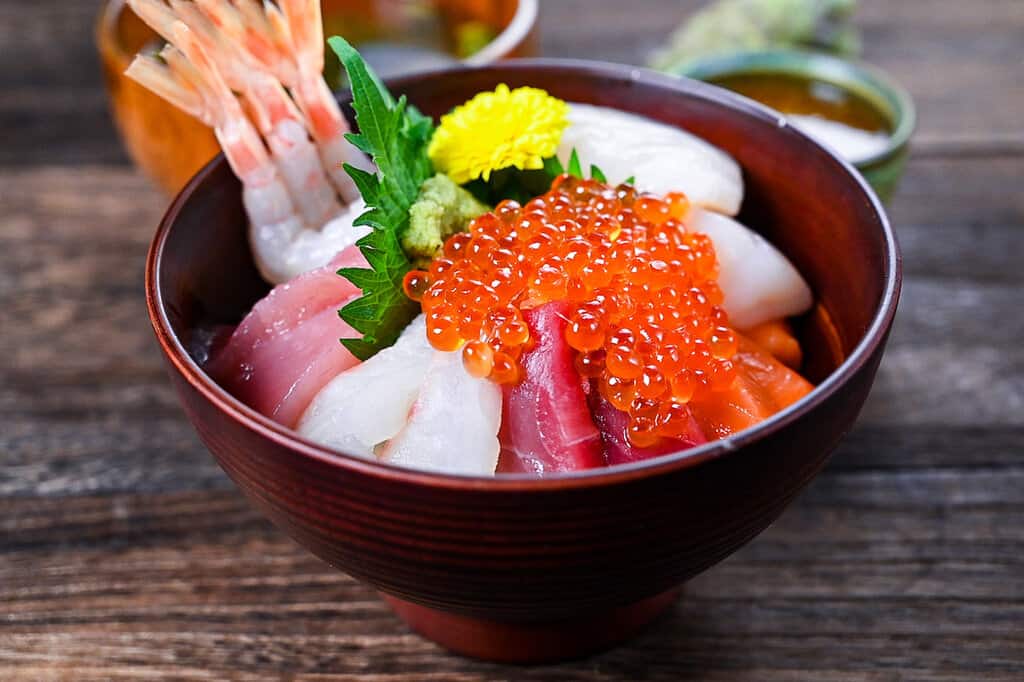
3. Pour soy sauce directly on the rice bowl
What many people tend to do is pour soy sauce directly on it. Surely this is the easiest way to apply soy sauce, but if you pour soy sauce over the entire kaisendon from the start, the soy sauce will accumulate at the bottom, and the rice may absorb too much, resulting in an overly salty kaisendon. And there is also a possibility that the taste of the fish itself will not be conveyed properly.
The solution is to prepare a small soy sauce dish on the side, then dip the seafood into the soy sauce, return it to the bowl, and eat it with rice. This way, the rice is not going to be soaked in soy sauce, and because the sauce only adheres to the fish, kaisendon won’t be full of soy sauce.
4. Do not mix kaisendon too much
This is also a a common problem as it’s easy to do: “Mixing all the ingredients before eating the kaisendon”. Not only does this ruin the beautifully coloured seafood ingredients, it also makes it impossible to taste the ingredients individually.
5. Wasabi directly on each piece of seafood
To enjoy the flavor of wasabi as a condiment and the flavor of each seafood, it is best to put a good amount of wasabi directly on the ingredients to bring out the best of each other. Not the advisable way, on the other hand, is mixing wasabi with soy sauce and mix all in. This way will tick the two boxes of “not advisable.”
If you want to use wasabi, the ideal way would be to dip the seafood in soy sauce, place an appropriate amount of wasabi on top, and then put it back on the rice.
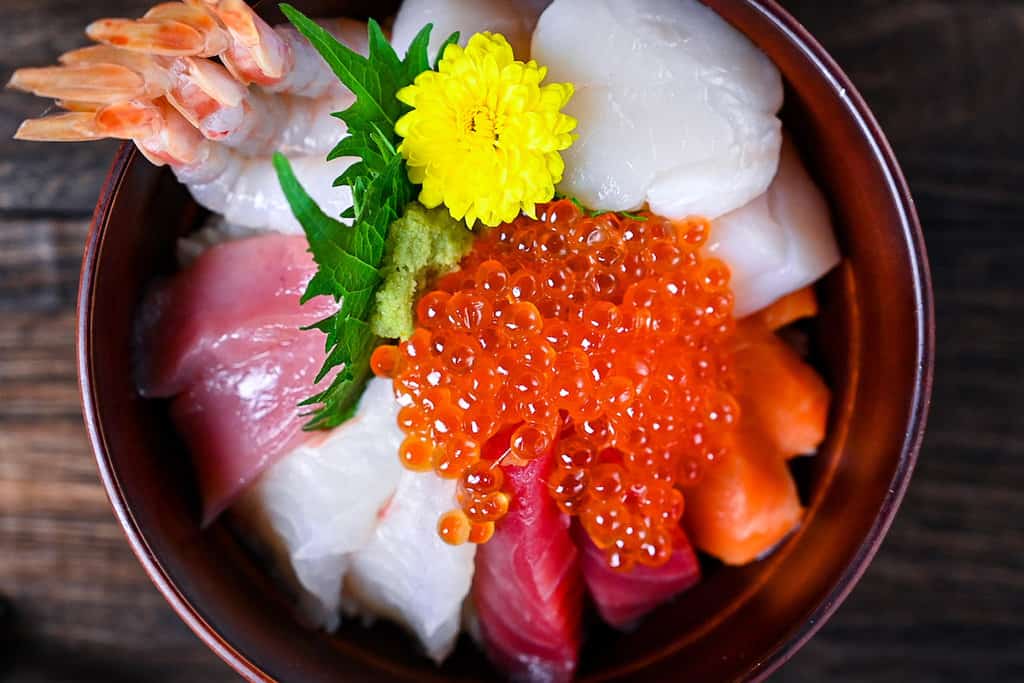
3 Topping/Variation Ideas
As you already know, you can use any type of seafood ingredients for this dish. Some might find it too much freedom of choice. So, I will list all the ingredients I had for inspiration!
Salmon & Ikura
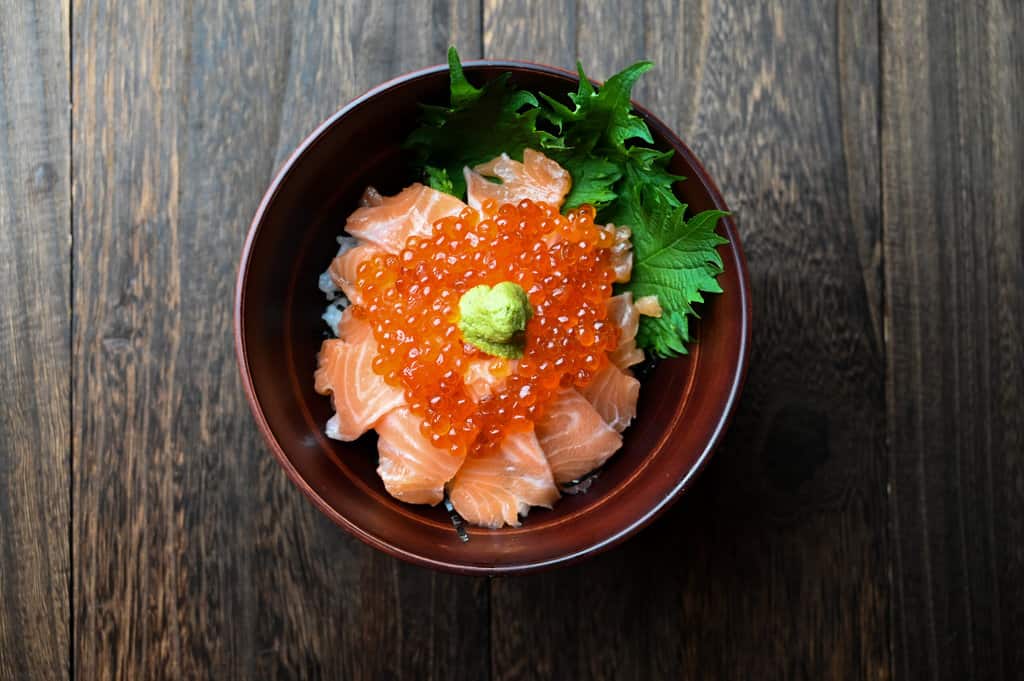
In a general sense, the term oyakodon means “parent and child rice bowl,” and it usually refers to chicken and egg donburi. However, technically, this variation of kaisendon can also be called oyakodon as it contains salmon and salmon eggs. This is one of the most popular variations in Japan, and it tastes great! I used beautiful Norwegian salmon topped with shiso leaves and wasabi.
Classic
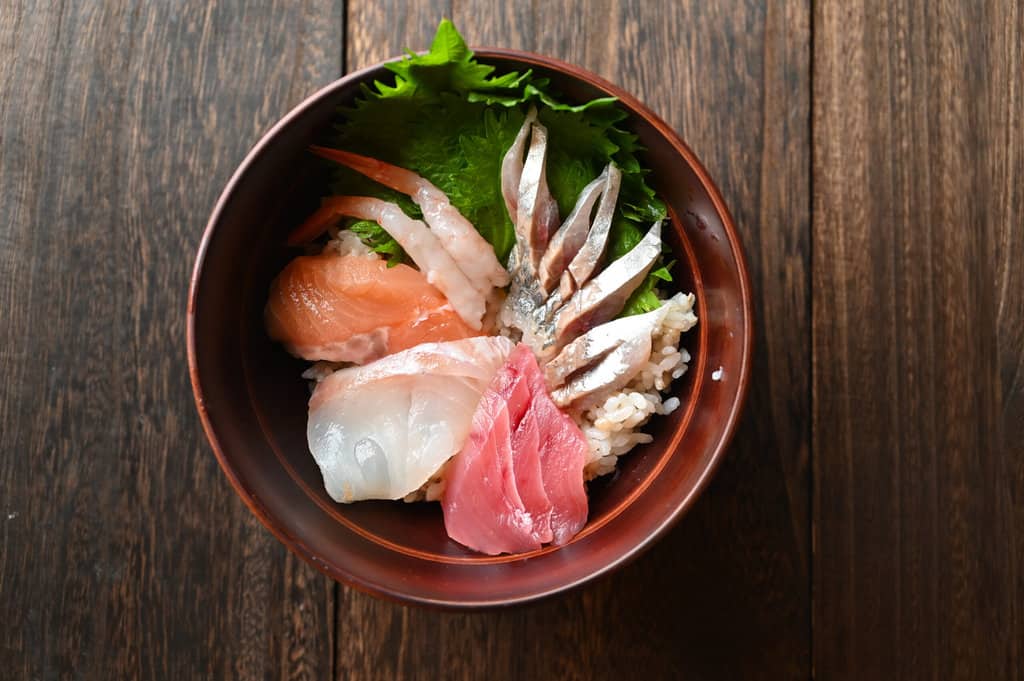
When it comes to sashimi, it can roughly be broken down into 3 categories: blue, red and white. What does that mean? Check the table with examples out!
| Blue (青魚) | Red (赤身魚) | White (白身魚) |
|---|---|---|
| Mackerel | Tuna | Red snapper |
| Horse mackerel | Skipjack | Cod |
| Pacific saury | Yellowtail | Flounder |
Everyone has a different opinion on that in Japan so I won’t delve into it now, but in this bowl, I used horse mackerel for blue, tuna for red, and red snapper for white. As a bonus, I added salmon and sweet shrimp.
Using one or two fish from each category can make your kaisen don more colorful!
Marinated
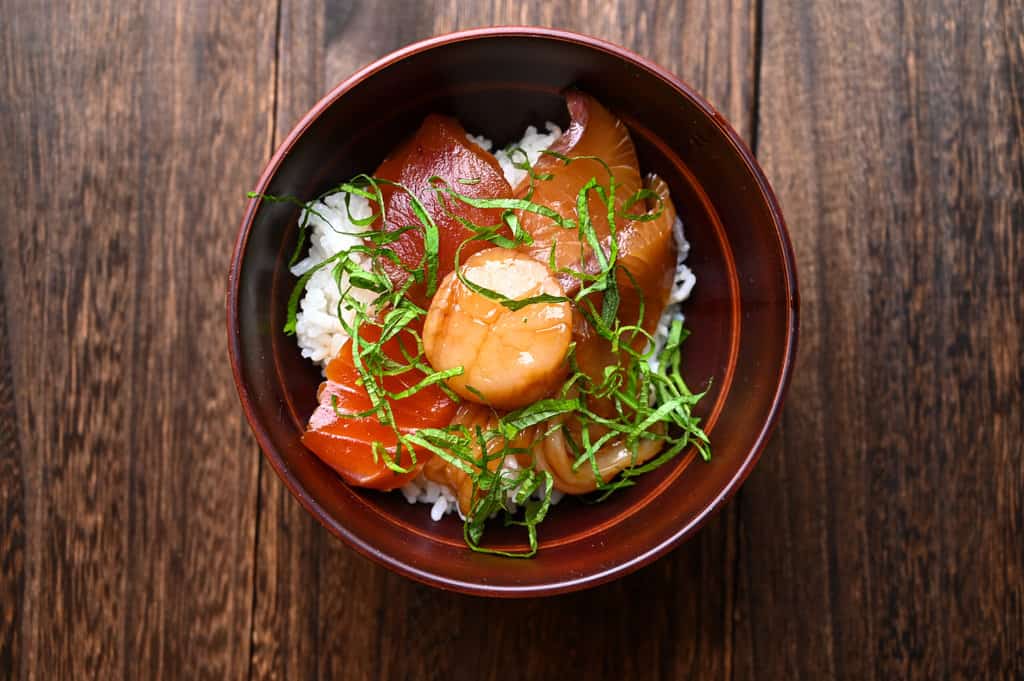
Ingredients of kaisen don can be marinated with soy sauce base marinade. You can check how to make the marinade in my zuke maguro don recipe here. My marinade is made quite sweet, so if you like sweet and savory at the same time, it’s definitely worth a try!
You can marinate any seafood, and in the specific picture, I used:
- Scallop
- Tuna
- Red snapper
- Squid
It’s topped with shiso leaves for some added fragrance!
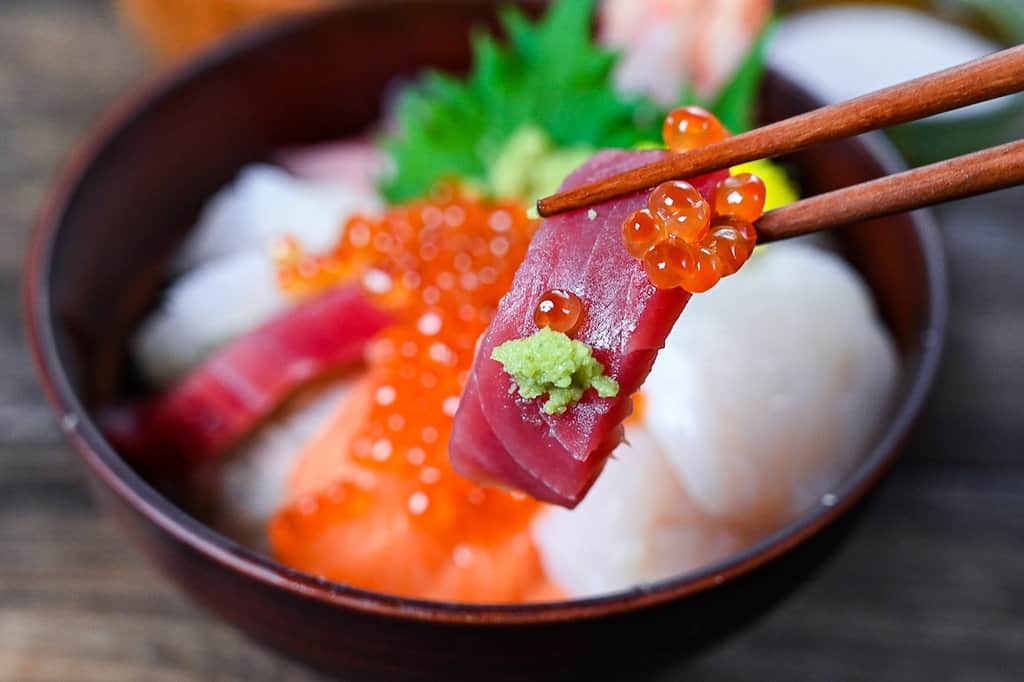
I hope you enjoy this Kaisen Don recipe! If you try it out, I’d really appreciate it if you could spare a moment to let me know what you thought by giving a review and star rating in the comments below. It’s also helpful to share any adjustments you made to the recipe with our other readers. Thank you!
More Seafood Donburi Recipes
- Maguro Zuke Don (Marinated Tuna Sashimi Bowl)
- Tekka Don (Red Tuna Sashimi Bowl)
- Negitoro Don (Mashed Tuna Sashimi Bowl)
- Unagi Donburi (Japanese grilled eel rice bowl)
Want more inspiration? Explore my Donburi Roundup Post for a carefully selected collection of tasty donburi recipe ideas to spark your next meal!
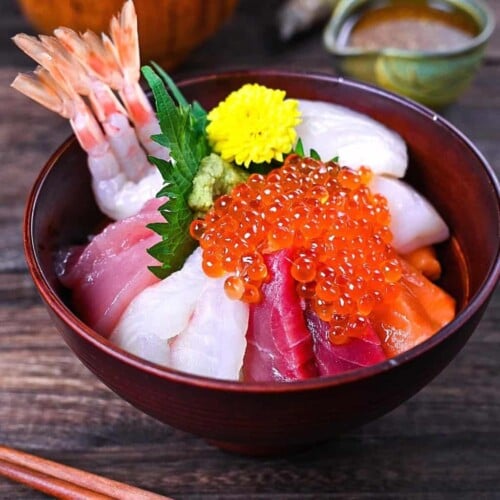
Kaisen Donburi (Seafood Rice Bowl)
Ingredients
Sauce
- 2 tbsp Japanese soy sauce (koikuchi shoyu)
- 1 tbsp light brown sugar
- ½ tbsp sake
- ½ tbsp mirin
- 50 ml dashi stock
- 1 tsp toasted sesame oil
- 1 tsp ground sesame seeds optional
Kaisendon
- 2 portions cooked Japanese short-grain rice
- 200 g seafood of your choice
- 2 perilla leaves (shiso) or nori / chopped green onion
- 1 tsp wasabi paste
Instructions
- Add 2 tbsp Japanese soy sauce (koikuchi shoyu), 1 tbsp light brown sugar, ½ tbsp sake, ½ tbsp mirin and 50 ml dashi stock to a small pan. Bring it to a boil, then reduce the heat and simmer for 5 minutes.
- Remove the pan from the heat and leave to cool. Transfer to a small dipping bowl and add 1 tsp toasted sesame oil and 1 tsp ground sesame seeds. Mix well.
- Divide 2 portions cooked Japanese short-grain rice into bowls and top with 200 g seafood of your choice.
- Garnish with shiso leaves, nori or chopped green onion.
- Apply wasabi to the fish and dip each piece in the sauce before eating. Enjoy!
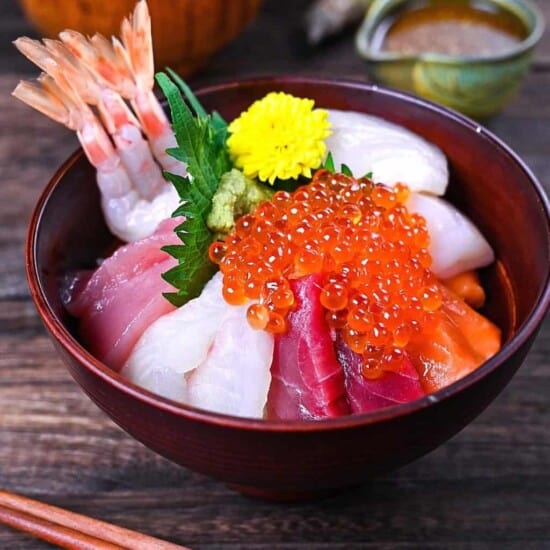


I appreciate the note about blue, red and white fish!
Hi Jan,
I’m glad to hear that it was helpful! 🙂
Yuto